- Understanding the Different Variants of KeyFit 30 and KeyFit 35
- Difference Between Chicco KeyFit 30 and 35
- Tables: Specification Comparison – Chicco OneFit VS Chicco NextFit
- NHTSA Ease-of-Use Rating
- General Features Comparison: Similarities and Differences
- Detailed Analysis of Both Models – Which is The Winner? – Helping you Make a Decision
- Chicco KeyFit 30 & 35; And their Base
- Chicco Keyfit 35 & 30 Stroller Compatibility
- Wrap-Up: Final Decision-Making Highlights
Buying an infant seat is one of the requirements to present at the hospital before you are discharged after delivery.
While you’re preparing ahead for that great ‘labor’ day or already have your newborn but still need an infant seat, you may have streamlined your needs to an infant carrier seat against a bulky convertible and settled for the Chicco brand but, are at crossroads on which to pick of the KeyFit 30 vs KeyFit 35.
This Chicco KeyFit 30 vs 35 comprehensive comparison aims to highlight their differences in detail while looking at specific aspects of a child restraint system such as safety rating & features, installation features, ease of use features, weight & height limits, the seat base, compatibility with strollers and other tiny details that matter such as seat weight, reclining positions and more.
Despite the differences between both infant carriers, picking one can be tricky.
While each model has different variants, the naming of the variants creates a tricky situation and a tough choice to make in the end. However, do not worry; I will walk you through making your dream choice for your little darling.
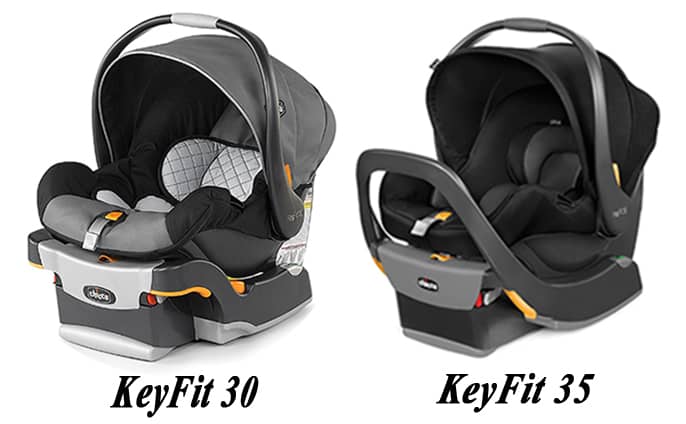
Understanding the Different Variants of KeyFit 30 and KeyFit 35
The naming of the different variants of each model makes it confusing on how to make a choice.
It will surprise you that there is not such a difference other than in the name and ‘maybe’ the fabric.
Let’s take a look.
KeyFit 30 Variants
The Chicco KeyFit 30 comes in three variants:
There is no difference between the KeyFit 30 and the KeyFit 30 Cleartex®. The presence of the name Cleartex only features a certification called the GREENGUARD GOLD that translates to low chemical emissions.
However, both variants are stated to be “produced without the use of intentionally added brominated or chlorinated fire retardant chemical treatments, PFAS, BPA, and phthalates.” They are priced at the same amount.
On the other hand, the KeyFit 30 Zip features a full coverage canopy that also comes with zippers that allow to open and close the canopy coverage. This canopy coverage is different from the one over the baby. It is just over the baby’s leg, hence the name Zip-Open Boot.
The canopy over the baby also has a zip-open mesh window that allows for ventilation from behind the baby. The KeyFit 30 Zip is more expensive than the other variants.
All other features and specifications, such as seat dimensions, seat weight, and weight & height limits, are similar.
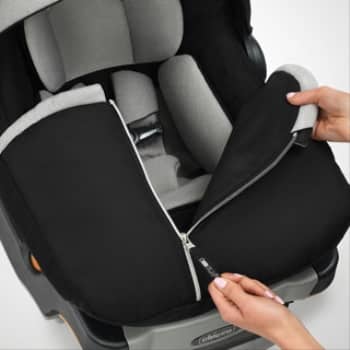
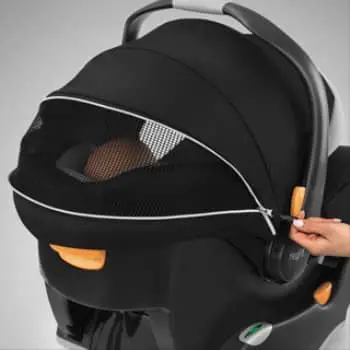
As you read further in this Chicco KeyFit 30 vs 35, you will be able to place your mind clearly on a specific variant of each model during the comparison.
KeyFit 35 Variants (KeyFit 35 vs KeyFit 35 Zip)
Similarly, the KeyFit 35 comes in three variants:
- KeyFit 35,
- KeyFit 35 Cleartex®, and
- KeyFit 35 Zip Cleartex®
Herein, the third variant includes the cleartex name, unlike in the KeyFit 30 Zip.
There is also no difference between the KeyFit 35 and the KeyFit 35 Cleartex®. The inclusion of the name Cleartex only features a certification called the GREENGUARD GOLD, as with the KeyFit 30, which translates to low chemical emissions.
However, both variants are also stated to be “produced without the use of intentionally added brominated or chlorinated fire retardant chemical treatments, PFAS, BPA, and phthalates.” They are priced at the same amount.
On the other hand, the KeyFit 35 Zip Cleartex® features a UPF 50+ full-coverage canopy that extends from over the baby to the front where the legs are, and with air-mesh by the sides for ventilation and a zip-open panel that houses the air-mesh coverage canopy. The KeyFit 35 Zip Cleartex® is more expensive than the other variants.
All other features and specifications, such as dimensions, seat weight, and weight & height limits, are similar.
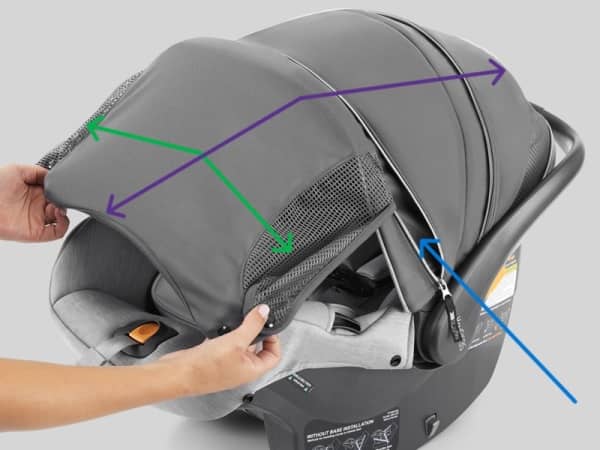
purple line: full coverage canopy
green line: air-mesh by the sides
blue line: zip-open panel
As you read further in this KeyFit 35 vs 30 comparison, you will be able to place your mind clearly on a very specific context, the variant of either model.
Difference Between Chicco KeyFit 30 and 35
Now, to the bigger picture, the first and distinct difference between the Chicco KeyFit 30 and 35 is the presence of an integrated anti-rebound bar on the KeyFit 35, which is absent in the 30. This is a special safety feature that keeps the infant seat stable during a car crash. It also provides extra legroom for a baby. All other differences include:
- A higher weight and height limits of 35 lbs and 32″ respectively, which earned it the name KeyFit 35 against the 30 lbs. and 30″ of the KeyFit 30.
- A premium LockSure® steel-reinforced seat belt locking system in the KeyFit 35 and an integrated belt lock-off system in the KeyFit 30.
- An extendable headrest system that adjusts simultaneously with the 5-point harness – a “no-rethread harness” system.
- 6 recline positions in the KeyFit35 against 5 positions in the 30.
- 5-position adjustable headrest in the 35 against 3-position in the KeyFit 30.
- The KeyFit30 weighs lighter (at 16.5 lbs – infant carrier – 9.5 lbs // seat base – 7 lbs) than the 35 (at 19 lbs – infant carrier – 10.5 lbs // seat base – 8.5 lbs)
- The KeyFit 35 is more expensive than the 30, as you would expect, albeit affordable and worth the penny.
It is important to note that both models have similar dimensions; as such, they will take up similar space in a vehicle.
However, the KeyFit 35 is an upgraded model from the 30 to include those features that make their difference. Otherwise, other features and specs are similar.
Tables: Specification Comparison – Chicco OneFit VS Chicco NextFit
| Specifications | KeyFit 30 | KeyFit 35 |
|---|---|---|
| Product dimension (inches) | 27.5D x 24H x 16.5W | 28D x 24H x 16.5W |
| Product weight | 16.5 lbs. – infant carrier – 9.5 lbs // seat base – 7 lbs. | 19 lbs. – infant carrier – 10.5 lbs // seat base – 8.5 lbs. |
| Seat modes | RF | RF |
| Recommended weight range | 4 – 30 lbs (1.8 and 13.6 kg) | 4 –35 lbs (1.8 and 15.9 kg). |
| Recommended height limit | 30 in. | 32 in. |
| Rear-facing weight limit | min. 4 lbs.; max. 30 lbs. | min. 4 lbs; max. 35 lbs |
| Rear-facing height limit | max. 30 in. | max. 32 in. |
| Forward-facing weight limit | n/a | n/a |
| Forward-facing height limit | n/a | n/a |
Price | ||
Price | Check on Walmart | Check on Walmart |
NHTSA Ease-of-Use Rating
The National Highway Transport and Safety Agency (NHTSA) provides a simple evaluation of car seats based on how easy it is to use different features in different modes. There is an overall ease-of-use rating for each seat to help you make a quick and informed decision.
This rating is based on four categories:
- Evaluation of Instructions
- Vehicle Installation Features
- Evaluation of Labels
- Securing the child
Ratings:
- 5 Stars = Excellent features
- 4 Stars = Above-average features
- 3 Stars = Average features
- 2 Stars = Below-average features
- 1 Star = Poor features
- N/A = Does not contain any feature that require a rating; or rating not available
| NHTSA | KeyFit 30 | KeyFit 35 |
|---|---|---|
| Rear-facing – overall rating | n/a | n/a |
| Forward-facing – overall rating | n/a | n/a |
General Features Comparison: Similarities and Differences
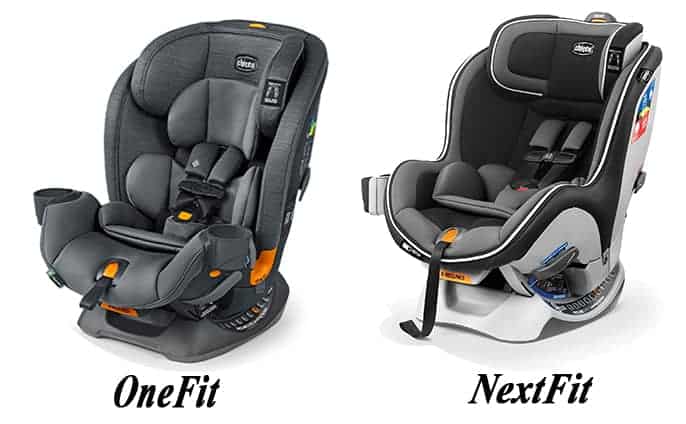
Safety Features
| Safety features | KeyFit 30 | KeyFit 35 |
|---|---|---|
| Impact Protection | ✔ | ✔ |
| EPS Energy-Absorbing Foam | ✔ | ✔ |
| 5-point Harness System | ✔ | ✔ |
| Meet or exceed federal safety standards | ✔ | ✔ |
Installation Features
| Installation features | KeyFit 30 | KeyFit 35 |
|---|---|---|
| LATCH/LUAS/ISOFIX system | ✔ + SuperCinch® LATCH tightener – easier installation with LATCH | ✔ + SuperCinch® LATCH tightener – easier installation with LATCH |
| Safety seat belt | ✔ + Integrated lock-off belt system | ✔ + LockSure® seat belt locking system – easier installation with belt |
| Level installation indicator | ✔ two RideRight bubble level-indicator | ✔ two RideRight bubble level-indicator |
Ease-of-Use Features
| Ease-of-Use features | KeyFit 30 | KeyFit 35 |
|---|---|---|
| Fits 3 Across Back Seat (@16.5″W) | ✔ | ✔ |
| Harness adjustment | ✔+one-pull tightening | ✔+Easy-Extend Headrest System with no-rethread harness |
| No-rethreading of harness | ❌ | ✔ |
| Machine washable | ✔ | ✔ |
| Car seat cover | ✔ Easy to remove | ✔ Easy to remove (zip-off cover) |
| Headrest adjustment | 3 positions | 5 positions |
| Recline positions | 5 positions | 6 positions |
| Recline Level Indicator | Bubble level // ReclineSure™ leveling system | Bubble level // ReclineSure™ leveling system |
Comfortability of a Child
| Comfortability | KeyFit30 | KeyFit35 |
|---|---|---|
| UPF 50+ canopy | ❌ | ✔ |
| Chemical-free fabric | ✔ | ✔ |
| Removable newborn inserts | 2 (head & body Newborn Positioner) | 2 (head & body Newborn Positioner) |
| Breathable 3D AirMesh (for enhanced airflow) | Only the KeyFit 30 with 3S AirMesh variant | n/a |
Longevity, Suitability and Compatibility
| Longevity & Suitability features | Key Fit 30 | Key Fit 35 |
|---|---|---|
| Expiration | 6 years (from Date of Manufacture) | 6 years (from Date of Manufacture) |
| FAA Approved (RF only) | ✔ | ✔ |
| Suitable country by law | USA | USA |
| Vehicle compatibility | Compatible with small, mid-size, full-size, vans and SUVs vehicles | Compatible with small, mid-size, full-size, vans and SUVs vehicles |
Miscellaneous features
| Comfortability | KeyFit30 | KeyFit35 |
|---|---|---|
| Available colors | 8 | 5 |
| Country of Origin | China (vis-à-vis American brand) | China (vis-à-vis Italian brand) |
| Body framework | n/a | n/a |
Detailed Analysis of Both Models – Which is The Winner? – Helping you Make a Decision

From the tables above, you can see that there are a few differences between these models. Which do you then pick?
Here is a detailed analysis of the differences between the 30 and 35, which can help you decide a winner.
Specification Comparison
This section covers the aspect of age, weight & height limits, product dimension/size, product weight & seat base.
Age, Weight, and Height Limits
The KeyFit 30 weight limits are between 4 and 30 pounds (1.8 and 13.6 kg); the KeyFit 35 weight limits are between 4 and 35 pounds (1.8 and 15.9 kg).
The Chicco KeyFit 35 height limit stands at 32 inches (81cm), while the KeyFit 30 height limit stands at 30 inches (76 cm).
The common height limit between both seats is that the top of your baby’s head is at least an inch (25 mm) below the top of the headrest, and when the harness straps can be positioned at or just below your child’s shoulders.
All these conditions must be fulfilled as the weight and height limit for either the KeyFit 30 or 35.
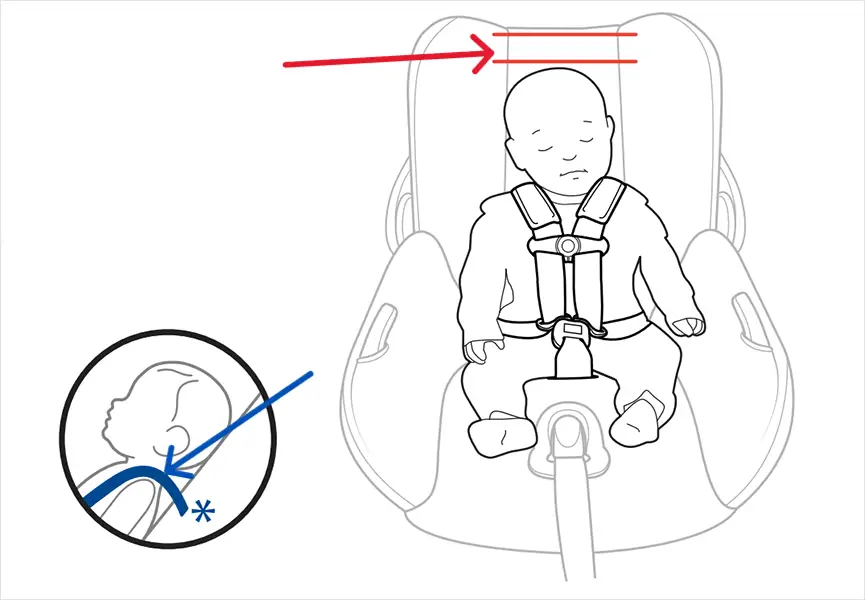
Chicco Keyfit 30 vs 35 Dimensions
The KeyFit30 vs 35 differ in dimension in the seat depth (footprint) by a meager 0.5″, which is insignificant.
- KeyFit30: (D x W x H) – 27.5″ x 16.5″ x 24″
- KeyFit35: (D x W x H) – 28″ x 16.5″ x 24″
Product Weight; Seat Base
The Key Fit 35 weighs 2.5 lbs more than the Key Fit 30.
- KeyFit30: 16.5 lbs. – infant carrier – 9.5 lbs // seat base – 7 lbs.
- KeyFit35: 19 lbs. – infant carrier – 10.5 lbs // seat base – 8.5 lbs.
If you look closely, the weight difference in the infant carrier is negligible at just 1 lb. You wouldn’t be carrying the base, so there is little to consider here.
Features Comparison
This section covers on the aspect of safety, ease-of-use features, comfortability for a child, and duration of usage (expiration).
Chicco Keyfit 30 vs 35 Safety Rating and Features
While the difference between these seats is the anti-rebound bar featured on the KeyFit 35, which is absent on the KeyFit 30, all other Chicco’s safety features, such as 5-point harness system, EPS energy-absorbing foams for impact protection, and installation features such as SuperCinch® are similar.
According to BabyGearLab report, the KeyFit 30 has a crash test score of 7.9, which is higher than that of the KeyFit 35 at 7.6; however, the overall score of the KeyFit 35 (at 75) is higher than 30 (at 75), with higher ease of installation (LATCH/safety belt), ease of use and comfort/quality scores.
More than just these ratings or scores are needed to judge a better car seat than the other, as all safety seats are manufactured to meet the very stringent federal requirements. As long as a child seat is not recalled from the market, it is considered safe for a child.
Nonetheless, either of these Chicco seats must not be used after 6 years from the date of manufacture.
Installation Features
The KeyFit 35 comes with Chicco’s SuperCinch® technology, which is a LATCH installation feature that ensures the connection of a car seat and the vehicle is tight enough to reduce movement. This is essential as car seats are recommended not to move beyond 1cm when pushed front-to-back and side-to-side.
The KeyFit 30 also comes with this SuperCinch® feature as other convertible car seats in the Chicco’s product line, like the Chicco NextFit vs OneFit.
However, the seat belt installation feature is where the difference lies between the 30 and 35.
The KeyFit 35 features Chicco’s premium LockSure® belt installation, which is a reinforce-steel seat belt locking system, unlike the 30 that comes without this. However, the integrated belt lock-off system is also easy and secure, just like those featured in Graco car seats.
Ease-of-Use Features
Recline position: while the KeyFit 30 features 5 recline positions, the KeyFit 35 adds one more to make 6. Recline positions help you position a seat in a way that fits best in your car while also providing comfort for your child.
This difference in positions doesn’t make a significant difference and may not need to influence your decision-making.
Height adjust positions & ‘no-rethread’ harness: you can adjust the KeyFit 30 in 3 positions; however, the KeyFit 35 offers two additional positions with a no-rethread harness system that allows you to simultaneously adjust the headrest and the harness as your child grows towards the height limit of 32″. This makes the KeyFit 35 a better choice.
Comfortability of a Child
A car seat that isn’t comfortable for a child isn’t worth the investment, even if it promises the highest safety rating.
The Chicco KeyFit 35 beats the 30 by a margin when it comes to comfort with its peculiar cushioning and UPF 50+ canopy features. Though the KeyFit 30 also features a canopy, the protective rating is not provided.
However, the common feature in these seats that gives a breath of fresh air when it comes to comfort is the zip-open mesh window that provides extra ventilation in any weather. Do note that this is only available in the KeyFit 30 Zip and KeyFit 35 Zip variants.
Nonetheless, they both include plush removable head and body inserts for an extra cozy feel.
FAA Approved
Either KeyFit30 and 35 are FAA-approved and can be carried along and used on an aircraft. You do have to refer to your manual on how to install it on an airplane.
Expiration
As with every child restraint, these infant seats have expiry dates. They have a life span of 6 years from the date of manufacture, and you must stop using them afterward.
Chicco KeyFit 30 & 35; And their Base
The Chicco KeyFit seat bases are designed intuitively, so you must pay careful attention to their usage for either seat and not mix them up.
While the KeyFit 35 base is a versatile seat base that can be used for all KeyFit infant seats, including the KeyFit®, KeyFit® 30, and KeyFit® 35 variants/models, the KeyFit 30 base can only be used for KeyFit® and KeyFit® 30 infant car seats.
Chicco KeyFit Base FAQs – (FAQ)
Will keyfit 35 fit 30 base?
No, the KeyFit 35 infant carrier will not fit into the 30 base. Still, the KeyFit 30 infant carrier will fit into the KeyFit 35 seat base.
Does the Chicco Keyfit 30 and 35 have the same base?
No, the Chicco KeyFit 30 and 35 do not have the same seat base. The KeyFit 30 base will not fit a KeyFit 35 infant carrier, but the KeyFit 35 base will fit either variant infant carrier.
Chicco Keyfit 35 & 30 Stroller Compatibility
One essential capability that makes the Chicco KeyFit infant seats stand out in the market today is its impressive compatibility with most strollers.
The following are Chicco Keyfit 35 compatible strollers:
- Chicco Corso LE Modular Travel System – it is paired with the KeyFit 35 (KeyFit 35 Cleartex); it is also compatible with the KeyFit 30
- Chicco Bravo 3-in-1 Trio Travel System (Bravo Quick-Fold Stroller) (no adapter required) – it is paired with the KeyFit 30
- Chicco Activ3 Jogging Stroller Travel System (no adapter required) – it is paired with the KeyFit 30
- Chicco Viaro Quick-Fold Travel System (no adapter required) – it is paired with the KeyFit 30
- Chicco Mini Bravo Sport Travel System (adapter included) – it is also compatible with KeyFit 30
The following are exclusively compatible with KeyFit 30 only:
- Evenflo Pivot Xpand Modular Travel System (adapter required) – it is paired with LiteMax Infant Car Seat with Anti-Rebound Bar
- Evenflo Gold Pivot Xpand Smart Modular Travel System (use with Evenflo car seat adapter)
Wrap-Up: Final Decision-Making Highlights
While these infant seats have peculiar similarities and some distinct differences like the weight and height limits, anti-rebound bar, and then the comfort and ease-of-use features like the “no-rethread harness“, making a decision on which to go for becomes straightforward from here on.
For the value and difference in price, the KeyFit 35 has more price advantage. Therefore, the KeyFit 35 becomes a better choice over the KeyFit 30. However, when you go further in to the variants, it then comes to personal preference on which to go for.
Nonetheless, both infant carriers are great. Their compatibility with strollers and flexibility with their seat bases even make any a great choice for your lovely newborn.
Cheers to happy parenting!

